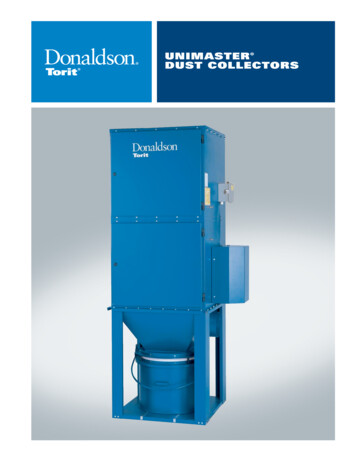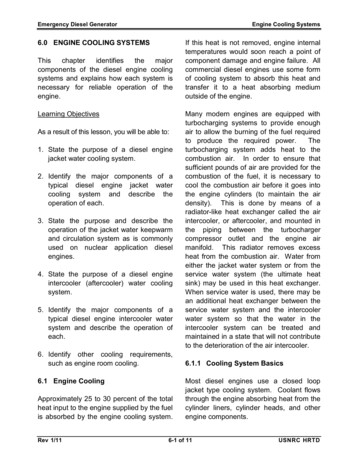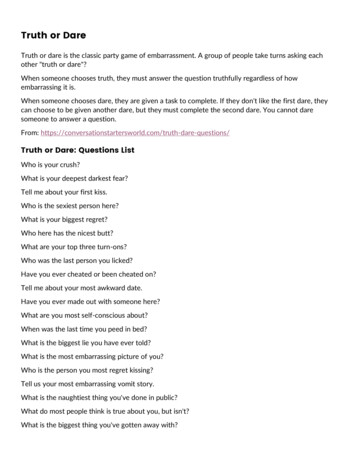![[dust Jacket] TRUTH OF THE STOCK TAPE - Gann.Su](/img/14/281923-29-20truth-20of-20the-20stock-20tape.jpg)
Transcription
[dust jacket]TRUTHOFTHE STOCK TAPEA STUDY OF THE STOCK AND COMMODITY MARKETSWITH CHARTS AND RULES FOR SUCCESSFULTRADING AND INVESTINGByWilliam D. GannA practical book written by a successful Wall Street man who hasproved his theory in actual trading. He writes from twenty years'experience and gives examples of his rules by the Case System.This is the only book published covering the investment andspeculative field of Cotton and Grain as well as Stocks. It is fullyillustrated with 22 charts showing plainly the successful method oftrading.In four books under one cover:Book IBook IIBook IIIBook IVPreparation for Trading.How to Trade.How to Determine the Position of Stocks.Commodities, including Cotton, Wheat and Corn.
TRUTHOFTHE STOCK TAPEA STUDY OF THE STOCK AND COMMODITY MARKETSWITH CHARTS AND RULES FOR SUCCESSFULTRADING AND INVESTINGBYWILLIAM D. GANNIN FOUR BOOKSEMBRACINGThe Preparation and KnowledgeRequired; Methods of OperatingAnd Determining Position ofStocks and CommoditiesFINANCIAL GUARDIAN PUBLISHING CO.91 WALL STREETNEW YORK.This E-Book is not to be sold.It is a free educational servicein the public interestpublished byGann Study Group
DEDICATEDTOMY SUBSCRIBERS WHO HAVE ENCOURAGED MEAND TO THETHOUGHTFUL STUDENTS OF FINANCIAL ECONOMICSWHO DESIRE TO FOLLOW PRACTICAL RULES FOR TRADINGINSTEAD OF GUESSWORK AND GAMBLING METHODS
PREFACE“Receive my instruction, and not silver; and knowledge ratherthan choice gold. For wisdom is better than rubies, and all thethings that may be desired are not to be compared to it.”-- PROV.8: 10-11.In addressing you on the subject of investing your surplusfunds, I might state that there is no other subject which Icould select that so closely concerns your welfare and regarding which you might receive valuable assistance from my instructions.In the United States a stupendous sum, reaching intomillions of dollars, is wasted annually in foolish speculationsand unwise investments. This senseless waste can be tracedto one and only one source, namely, lack of knowledge. Menand women who would not attempt to treat the slightestailment, or even adjust so common a thing as a kitchen faucet,but would hand each difficulty over to its respective specialist,the doctor or the plumber, will on the spur of the momentand without the slightest preparation, undertake the investment of thousands of dollars in enterprises about which theyunderstand absolutely nothing. Is it any wonder then thatthey lose?I offer you suggestions and advice in the science of speculation and investment in the same spirit as the physician. Hewould not think of guaranteeing you perpetual life or insuring you against the common ills to which the flesh is heir.But in your difficulties he brings to your aid the accumulatedexperience of his profession, and a skill and knowledge whichrequired years to accumulate and is ready for your instantuse. I do not offer you a beautiful theory which will notwork in practice, but give you invaluable advice, which iffollowed, will insure success in practical everyday Wall Streetspeculations and other fields of investment.v
viIt has been well said that a writer who writes first forremuneration and secondly because he believes what hewrites, will never achieve enduring fame, and that the salesman who does not believe in his goods will never make asuccess. I believe in the theory and rules that I have laiddown in this book for you to follow, because I have testedand proved them.It is my object in this work to facilitate and focalize theessential principles for practical use. My knowledge comesfrom over twenty years' experience, in which I have traversedthe rough and rugged road that the inexperienced trader'sfoot must press before he reaches the goal. Hence my objectin writing this book is to give to the public something newand practical, not theory alone which would fail in practice.Read this book carefully several times; study each chartand subject thoroughly, and a new light and knowledge willcome to you every time you read it.If I succeed in teaching only a few to leave wild gamblingalone and follow the path of conservative speculation andinvestment, my work will not have been in vain and I willhave been amply repaid for my efforts.W.D. GANN.NEW YORK CITY,January 27, 1923.
CONTENTSBOOK IPREPARATION FOR TRADINGCHAPTERPAGEI. WHAT IS TAPE READING?2II. CAN MONEY BE MADE IN WALL STREET? ORCAN THE STOCK MARKET BE BEATEN?3III. HOW TO READ THE STOCK TAPE5IV. HOW THE TAPE FOOLS YOU8V.HOW STOCKS ARE SOLDVI. YOUR WEAK POINTSVII. ESSENTIAL QUALIFICATIONS162022BOOK IIHOW TO TRADEVIII. RULES FOR SUCCESSFUL TRADING28IX. METHODS OF OPERATING40X. CHARTS AND THEIR USE51XI. THE SEVEN ZONES OF ACTIVITY55XII. HABITS OF STOCKS59XIII. DIFFERENT CLASSES OF STOCKS68XIV. HOW TO READ THE TAPE CORRECTLY76XV. WHEN THE TAPE FINISHES AND GIVES FINALSIGNALS83vii
viiiBOOK IIIHOW TO DETERMINE THE POSITION OFSTOCKSXVI.POSITION OF GROUPS OF STOCKS88XVII. GENERAL TREND OF THE MARKET90XVIII. HOW TO TELL THE STOCKS IN STRONGESTPOSITION93XIX.HOW TO TELL WHEN STOCKS ARE IN WEAKPOSITION99XX. JUDGING FINAL TOPS AND BOTTOMS103XXI. NUMBER OF TIMES A STOCK FLUCTUATESOVER THE SAME RANGE114XXII.CROSSING OLD LEVELSXXIII. TOPS AND BOTTOMS ON RAILROAD STOCKS117127XXIV. BOTTOMS AND TOPS ON INDUSTRIAL STOCKS 135XXV. ACCUMULATION OF LOW-PRICED STOCKS143XXVI. HOW TO WATCH INVESTMENTS146BOOK IVCOMMODITIESXXVII.XXVIII.XXIX.XXX.XXXI.XXXII.HOW TO TRADE IN COTTON152PROPER WAY TO READ THE COTTON TAPE158HOW TO DETERMINE A CHANGE IN TREND165THE BOLL WEEVIL168WHEAT AND CORN TRADING170JUDGING ACCUMULATION AND DISTRIBUTIONZONES173SELECTING A BROKER185
b.Dow-Jones’ Averages: Yearly High and Low6620 Industrial Stocks: 1896-1922.20 Railroad Stocks: 1885-1922.Studebaker Weekly High and Low77September 4, 1920, to January 6, 1923.U. S. Rubber Monthly High and Low: 1914-1922. 84Continental Can Monthly High and Low: 1914192391New York Central Swing Chart: 1896-192296U. S. Industrial Alcohol Monthly High and Low:1914-1922100U. S. Steel -- 3-point Moves: October 2, 1916, toDecember, 1917105American Smelting and Refining Monthly High andLow: 1901-1908107Corn Products Monthly High and Low: 1906-1922110-111Republic Steel Monthly High and Low: 1913-1922.118Dow-Jones’ Averages -- Monthly High and Low -20 Railroad Stocks: 1896-1922128-131Dow-Jones’ Averages -- Monthly High and Low -20 Industrial Stocks: 1897-1922136-139October Cotton Weekly High and Low: November,1919, to January, 1923160-161May Wheat Monthly High and Low: 1895-1922174-176May Wheat Swing Chart: 1895-1922178May Wheat Weekly High and Low: April 16,1921, to January 6, 1923182May Daily Wheat High and Low: December 13to 29, 1922182
Perhaps one of the wisest things Emerson ever said:"Many times the reading of a bookhas made the fortune of a man -has decided his way in life."To use books rightly is to go to them for help;to appeal to them when our knowledge and power fail;to be led by them into wider sight and clearconception of our own."
TRUTH OF THE STOCK TAPEBOOK IPREPARATION FOR TRADING“No man can learn what he has not preparation for learning,however near to his eyes is the object. A chemist may tell his mostprecious secrets to a carpenter, and he shall be never the wiser -- thesecrets he would not utter to a chemist for an estate.” -- EMERSON.In 1917 when the United States was forced to enter thewar against Germany we heard on every hand “we are unprepared for war.” Wilson’s period of “watchful waiting”instead of preparing for the inevitable had at last broughtus face to face with war without being ready.Lawyers, doctors, engineers and professional men whomake a success spend anywhere from two to five years’ timestudying and preparing to practice their profession beforethey begin making any money.Men enter into speculation in Wall Street without anypreparation. They have made no study of it whatsoever.They try to deal in something they know nothing about. Isit any wonder then that they lose?Speculators and investors who simply guess, follow tips,rumors, newspaper talk and so-called “inside information"have no chance of ever making a success. Unless they followsome well-defined plan based on Science and Supply andDemand, they are sure to lose.Over twenty years of study and experience places me ina position to give you a definite, practical set of rules andinstructions which will lead to success if you follow them.No great success or gain can be expected unless a manis willing to study and learn by past experience. You cannotget something good for nothing and must pay with time,money, or knowledge for success.1
CHAPTER IWHAT IS TAPE READING?Tape reading is a study of fluctuations of stocks as theyappear on the stock tape and the ability to judge the onesthat are in a strong or weak position and determine thepsychological moment to buy or sell. We must also be ableto determine the stocks that are inactive and show no definitetrend.Tape reading is psychological because the mind acts andis influenced by everything it sees, hears, smells, tastes orfeels. In reading the tape, we are not influenced alone bywhat we see, but by what we feel or sense, which cannotalways be explained or a satisfactory reason given becauseit is “intuition.”What is intuition? You often hear traders say “I ambuying or selling this stock on my intuition. The best definition I can give of intuition is that it is instantaneous reasoning.It is that something which tells us when we are right orwrong before we have time to reason it out. The way tobenefit through intuition is to act immediately, and not stopto reason or ask why. That is what a good tape reader does.The tape registers the dominating force currents frombusiness all over the country. It contains the condensedopinion of the majority and weighs the hopes and fears ofmanipulators, the public, and business men. That is why itis a reliable guide and business barometer, if you know howto read it correctly. And here is where the “rub” comes.The tape tells the truth, if you can interpret it correctly.Tape reading requires a strong will power and a mindthat, when it once sees the trend of the market, cannot bechanged until the tape shows the change and is not influencedby news, false rumors, tips, or hearsay. Being able to readthe tape correctly and act on your judgment is an entirelydifferent proposition, which I will explain later on.2
CHAPTER IICAN MONEY BE MADE IN WALL STREET?ORCAN THE STOCK MARKET BE BEATEN?You have often heard the expression “99 out of every100 who go into Wall Street lose.” Then one man out ofevery hundred must win. Therefore, my answer is that WallStreet can be beaten and that you can make money by speculating and investing along conservative lines and by tradingin a few selected stocks.But how are you going to do it? You must have knowledge and science. Know! Know !! Know!!! more thanthe other fellow or the common trader. Find out how successful men in Wall Street have made their fortunes; thengo and do likewise. Remember that “Knowledge is Power.”Statistics show that 98 per cent of business men failsooner or later. Then why do men go into business? Because 2 per cent of them make fortunes out of general business and keep them.Just ask yourself the question, “Who gets all the moneythat is lost in Wall Street?” It does not evaporate; forevery dollar lost some one makes a dollar. Then the wayto make it is to trade the same way the fellow does whogets what you lose. Remember that every time you buy someone sells and every time you sell some one buys.The majority of people who buy stocks lose money in theend. Why? Because they guess, follow newspaper dope,fake tips or inside information. They do not make safeinvestments; they gamble on 10 or 15 points’ margin. Theynearly always buy near the top, and, of course, nothing cankeep them from losing.3
4The general public do not sell stocks short; thereforethey are always wrong in a Bear market. When a man losesmoney buying stocks and refuses to sell short, he can alwayslook back and say “if I had only sold when I bought, lookhow much profit I would have made.” Then, why doesn’the learn to sell short? (In another chapter I will show youthe proof that it is safe and practical to sell short.)At the present time, there are over 700 stocks listed onthe New York Stock Exchange, and if you group them undertheir proper headings, there will be over 20 different groups.If you study the action of all the stocks in one group andwatch them on the tape, you will find it is too much for you,and that you cannot make money trading in all of the stocksin any one group, much less by trying to trade in severalgroups.Tape reading requires patience, and the essence and valueof it is concentration. There is no such thing as a man beingborn with a mind that can concentrate on 10 things at onetime, much less 700. Then success depends upon selectinga few stocks and concentrating upon them.
CHAPTER IIIHOW TO READ THE STOCK TAPEThe general opinion prevails with the public, especiallyamong traders outside New York City, that the proper wayto read the tape is to stand at the ticker and watch everyquotation as it comes out. Nothing is more erroneous.Expert tape readers are very few and far between. Itis a study of a lifetime. While the tape shows the trend ofthe market, there are so many minor changes and quickreversals that the average man can not tell whether the bigtrend has turned or whether it is only a minor change thatwill last a few hours, a few days, or a few weeks before themain trend is resumed again.If a trader goes into a broker’s office to watch the tape,he will find anywhere from two or three to a dozen tradersstanding around the ticker, all talking from time to time andexpressing their opinions or what they hear on differentstocks. He must also listen to the gossip that comes overthe news ticker, floating rumors from the street, and information about buyers and sellers that comes from the floor. Withall of these disturbances, there is not one man in a millionthat can concentrate enough to tell anything about whatstocks are going to do.Besides, if he is able to pick a winner, and starts to buyor sell, he will be influenced by what someone says who isstanding around the ticker and the result is that he will notact at the right time. Then it is impossible to beat themarket by tape reading in a broker’s office.No matter how strong a man's will power may be, he isinfluenced, consciously or unconsciously, by what he hears orsees, and his actions or executions are interfered with accordingly. This is the reason why a few big traders, like Livermore, have a private office with a ticker, where they can be5
6away from all outside influences and watch the tape, formtheir impressions, and act on them without being influencedby things they do not want to hear. But only traders whohave a very large amount of money and can devote all oftheir time to the market and tape reading can afford to havean office and a ticker where they can study the tape alonewithout interference. The average man cannot afford this.Then it is necessary to know how to read the tape withoutseeing it, or without watching it all the time. Market movements of importance, i.e., the long swings, require weeks andsometimes months to get ready, or for accumulation anddistribution to be completed. There is always plenty of timeto buy or sell one or two days after a big move gets underway. Therefore it is not necessary to watch the tape everyday, or every hour, in order to determine what stocks aregoing to do. It can be read just as easy and better after themarket closes. The tape is simply a record of prices, and ifyou have this record of high and low prices made during theday, you can form your judgments from it.Market movements depend upon Supply and Demand.It requires volume of trading in proportionate large or smallamounts to move stocks up or down. The volume of salesto the stock market is the same as the steam is to the locomotive or the gasoline is to the automobile. The sales are themotive power which drives prices up or down.For example: United States Steel has five million sharesof common stock, and it requires a very large volume of salesto move this stock up or down very much. General Motorshas fifty million shares of common stock and its fluctuationsare confined to a very narrow range, because the buying orselling of 100,000 shares will not move it more than a point,if that much, while the buying of 100,000 shares of Baldwinwill often move it up or down five or ten points, because thereare only 200,000 shares of Baldwin outstanding and seldomever over 100,000 shares of stock floating in the street.Therefore, in order to understand the meaning ofvolume, you must know the total capital stock outstandingand the floating supply of the stock you are trading in. MexPete for several years has made moves of from 50 to 100points while U. S. Steel has not moved 10. The reason was
7that the floating supply of Mex Pete was very small whilethe floating supply of U. S. Steel was very large.Another thing the tape reader must know is the financialposition of the stock, whether it is weak or strong. It is noteasy to frighten investors and traders and start a sellingmove in a stock which is generally known to be in a verystrong financial position. Neither is it easy to force a stockby manipulation to very high levels that is generally knownto have very little intrinsic value. Many stocks, known as“Mystery Stocks,” which are supposed to have large concealed assets, often have big moves up or down because thepublic buy or sell on the hope that something favorable isgoing to happen or on the fear that something unfavorableis going to happen.As a rule, a stock that pays extra dividends or cuts amelon, is talked about and rumors circulated months andeven years before the actual event takes place. Then, ofcourse, when the good news comes out, it has been anticipatedand discounted and the stock declines instead of advancing,as the public expect.The tape is the great scale in which the weight of allbuying and selling is weighed and the balance of Supply andDemand shown by the loss or gain in prices. When Supplyexceeds Demand, prices decline to a level where Supply andDemand are about equal. At this stage fluctuations becomenarrow and it may require weeks or months to determinewhich way the next move will be. When Demand exceedsSupply, prices advance.Then how can the man who stands over the ticker dayby day determine a big move before it starts? He can not.The ticker will fool him once or twice each day whileit is getting ready. It requires time to buy a large amountof stock when accumulation is taking place, and it requirestime to distribute a large amount of stock at the top. Oneday, one week, or one month is not enough for a big move.Sometimes it requires several months, or even a year, tocomplete accumulation or distribution. While this processis going on, you can keep up a chart of the stock you areinterested in and judge much better when the big move starts,than you can by watching the ticker every day.
CHAPTER IVHOW THE TAPE FOOLS YOUThe tape is used to fool traders, for often when stockslook the weakest on the tape, they are the strongest asaccumulation is taking place. At other times when they arebooming and very active and appear the strongest, they arereally the weakest, because the insiders are selling whileeverybody is enthusiastic and buying.The man who watches the tape daily is influenced by hishopes and fears. He can not help it. Suppose that themarket has been strong all day, and the very stocks that heis interested in are gradually moving up, when suddenly,around 2:30 P.M. the market starts to break. It goes downfor fifteen minutes and active stocks are off a point from thehighs all around. It does not rally and by five minutes to 3,or closing time, they are off another point. The volume isheavy and he decides that something is wrong and he sellsout at the close. The next morning stocks open up from1/2 to 1 point. Why? Because the selling in the last halfhour the day before was simply the result of profit takingand all of the traders who were scared sold out at the closerather than carry them over night, the result being that thesupply of stocks to be offered next morning was limited,and the reaction had in no way interfered with or changedthe main trend.One great mistake the man makes who watches the tickerall the time, is that he trades too often. He gets in and outsometimes several times during the day, and each time hepays commission. If he buys or sells higher or lower eachtime, even though he has made profits on his trades, he isincreasing the percentage against him. A man who makes300 trades in the year, or, say, one for each market day, mustpay an average of 1/2 point getting in and out. It cannot8
9be done for less. Then 1/2 point on 100 shares 300 times,is 150 points for expenses during the year. Where is theman who can make money with such a handicap? Supposea man makes one trade each month, or twelve trades duringthe year. His expenses are only six points against thescalper’s expense of 150.Another important fact traders overlook is that the moretimes a man gets in or out of a market, the more times hechanges his judgment. Therefore, the percentage of hisbeing wrong increases. In a bull or bear market, there areoften big reverse moves opposite to the main trend, fromwhich big profits can be made, but a man can not catch themby jumping in and out every day. He must wait until hehas a real cause and sufficient reasons, based on facts, beforehe makes a trade. If he jumps in or out on hope or fear,he will not only make losses, but he will miss the real opportunity when it comes. The daily moves generally mean verylittle to the main trend of the market.OVERNIGHT BUYING OR SELLING ORDERSAs a rule, out-of-town buying orders accumulate overnight. If the buying orders are in excess of the selling,stocks will advance for the first thirty minutes, while thepublic’s buying orders are being filled. Then a reaction willtake place. Prices may go lower than they were at theopening; drift along in an uncertain way until about 2 :30P.M. when the professional crowd on the floor decide toeven up; then either advance or decline for thirty minutes,according to whether the floor traders are long or short.Remember that the professional floor traders have nocommission to pay. You can buy a stock that goes up 1/2point; then sell out and you are just about even, after payingtaxes and commission, while the scalper on the floor makes1/2 point, because he saves the commission.The newspapers on Sundays usually carry a review ofthe market for the past week and the public, after readingall of the news, send in their buying and selling orders forMonday morning. If the orders are very heavy, they willinfluence the market for thirty minutes and sometimes one
10hour. After this, the trend of the market will be the opposite.A market that has been strong during the week or especially during the latter part of the week and closes strongon Saturday, is likely to open strong Monday and finish theadvance in the first hour on Monday. Therefore, be verycareful about buying stocks on Monday morning’s strongopening. Public buying orders which accumulate over Sunday are all executed Monday morning and as soon as thisdemand is supplied professionals start selling and the markethas a reaction in proportion to its condition and position atthe time.Even if it is a bull market and going higher you will beable to buy cheaper on Monday afternoon or Tuesday whenthe professionals are hammering prices down after the publicbuying wave has been satisfied.The above rule is reversed in a declining market. Ifstocks have been weak all the week or during the last twoor three days of the week, and close at the low on Saturday,forced selling by the public will come in Monday morningand cause lower prices during the first 30 minutes to onehour. After this pressure is off, the market will rally. Therefore, it pays to sell on a strong rally Monday or to buy ona weak market on Monday morning. This rule of courseapplies to normal markets.FALSE HOPESAnother point, when a man is long or short of the market,and has a loss, it is but human nature to hope that the tradewill go his way. Suppose he is called for margin early inthe day. He tells his broker that he will either put up themargin before the close or sell out his stocks. The result ishe waits all day, and the market fails to rally. The last hourcomes, and hope gives away to despair and he sells out at theclose, which causes the market to close weak and near thebottom, because hundreds of people are doing the same thingat the same time.The same rule applies to people who are short of the market. Stocks start advancing early in the day, and they wait for
11a reaction on which to cover. They look for a reaction aroundthe noon hour, but it fails to come. Again around 2 :00 P.M.the market is stronger, and they hope for a reaction, but theadvance continues, with the result that near the close all ofthe shorts get frightened and buy in their stocks. Of course,the market closes on top and is left in a weak technical position, and the next day the reaction comes.For a trader to succeed, he must study human nature anddo the opposite of what he finds the general public does.The first day of a decline no one worries much, because theyconsider it a natural reaction. A market will often startdeclining on Wednesday. On Thursday the decline continues,and the traders begin to sit up and take notice and think theyhad better get out on the next rally. But Friday comes, andno rally; instead stocks get weaker. Why? Because peoplewho would not sell on the first or second day of the declinebegin to sell on the third day, and by Saturday the wholecrowd gets scared and decides to get out and not go overSunday. The result is that prices will break badly in the lasthour and close near the bottom, while the wise trader or tapereader who knew his business sold on the first indication ofweakness the first day and did not wait until everybody wasselling.This same rule applies to declines and advances lastingweeks or months. The longer the market goes one way orthe other the greater the buying or selling in the last stage,because hope or fear increases as the market advances ordeclines, and it is hope and fear, not sound judgment, thatmost people trade on.STOCKS DISCOUNT FUTURE EVENTSThe stock market is an accurate barometer of businessconditions. Stock prices are nearly always six to twelvemonths ahead of business conditions. First bond prices rise;second stocks advance; third comes business boom. Thesame happens in a decline. Stocks will be down six to eightmonths while business is booming, because they are discounting the future business depression.Market movements, that is, the main swings, are the
12result or effect of causes which, as a rule, exist long beforethe effect is known to the general public. In most cases, newsis discounted before it comes out and seldom has much effectafter it is generally known. Either good or bad news thatis expected usually falls flat as far as the effect on the marketis concerned.For instance, an extremely good or bad quarterly orannual report on a stock comes out and the market does notgo up or down on it for the reason that it is not news tothose on the inside. They knew it thirty to ninety days beforehand. Therefore, when the public gets the news and actson it, it is too late, for those on the inside who “know” havealready discounted it.If bad news comes out suddenly and stocks start sellingoff in large volume, then it is safe to assume that the marketis going lower, that the public is long of stocks and theinsiders are out. If good news appears and stocks startdown, it shows that it has been discounted. Your chartswill show whether the market is in a period of distributionor accumulation.SUDDEN UNEXPECTED NEWSSometimes sudden, unexpected events happen unforeseen.For instance; the earthquake in San Francisco in 1906 waswholly unexpected and unforeseen by either the public or theinsiders. It caused great loss and damage to property, andthe market started breaking immediately after it, and declined for several weeks until it discounted the damage doneto the various properties affected in that territory. Whennews of this kind comes out, that the market has not hadtime to prepare for, its full weight and effect must be feltafter it comes out.On February 3, 1917 Germany suddenly and withoutwarning declared the U-Boat war against the United States.The stock market had not fully discounted this event becauseneither the general public nor the insiders knew it was coming.Once the news was out, everyone knew that it meant that theUnited States must enter the war against Germany. Therefore, it was bad news which had not been fully discounted
13and the market had yet to measure its effect. The result wasthat stocks opened off anywhere from 5 to 20 points, butsupporting orders had been placed and the buying by shortsafforded enough support to stop the decline in the first hourof trading.When a move of this kind occurs and a market opensaway up or down, making a wide range, it is always wellto sell out long stocks or cover shorts and wait, because indoing this you are following what the big traders do. OnFebruary 3rd, after you saw the market open down onheavy selling and you watched it for thirty minutes and sawthat prices did not get much lower than the opening, it wouldbe an indication that prices had opened at a level where therewas support and that a rally would come. If you were short,the proper thing to do would be to cover at the market, thenwait and see how stocks acted on the rally that day and thefollowing day. If the rally was small
WILLIAM D. GANN IN FOUR BOOKS EMBRACING The Preparation and Knowledge Required; Methods of Operating And Determining Position of Stocks and Commodities FINANCIAL GUARDIAN PUBLISHING CO. 91 WALL STREET NEW YORK. This E-Book is not to be sold. It is a free educational service in the public interest published by Gann Study Group










